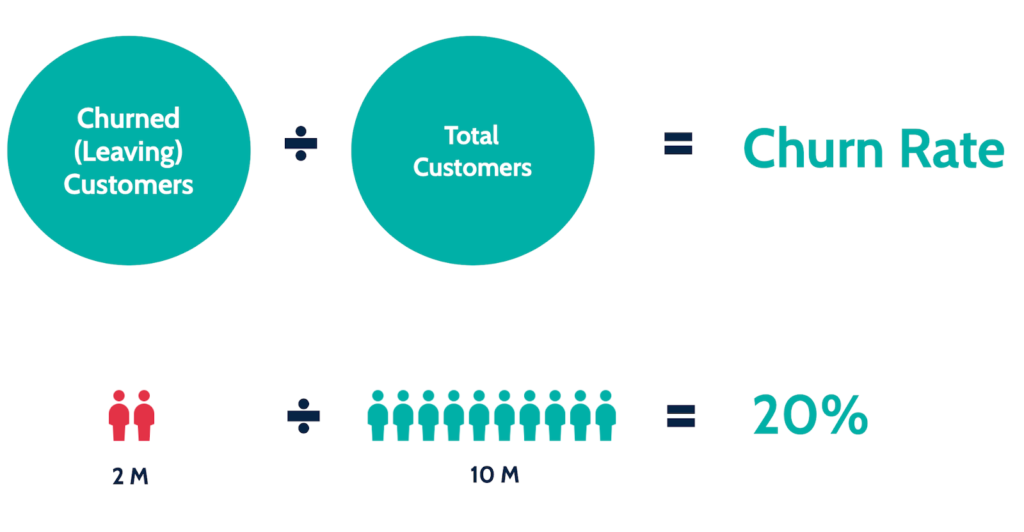Running a successful business isn’t just about attracting new customers; it’s equally important to keep the customers you already have. This is where churn analysis comes in. But what exactly is churn, and why should you care about it? Let’s break it down in simple terms.
What Is Churn?

Churn refers to the number of customers who stop using your product or service during a specific period. Imagine you run a subscription-based business, like a magazine or a streaming service. If 100 people cancel their subscriptions this month, that’s churn. In essence, churn is the rate at which your customers are leaving.
Why Should You Care About Churn?
Losing customers is bad for business. Here’s why:
1. Revenue Loss: When customers leave, your business loses revenue. This is particularly significant if those customers were regular or high-spending ones. Over time, even a small increase in churn can lead to a substantial decrease in your earnings.
2. Cost of Acquiring New Customers: It’s often said that it costs five times more to acquire a new customer than to retain an existing one. If your churn rate is high, you’ll need to spend more on marketing and sales to replace those lost customers. This can quickly eat into your profits.
3. Customer Lifetime Value (CLTV): The longer a customer stays with your business, the more value they provide. High churn rates reduce the average CLTV, meaning you’re getting less return on the investment you made to acquire each customer.
4. Brand Reputation: A high churn rate can be a red flag to potential new customers. If people see that many others are leaving your service, they may question its value and reliability.
Solvenna’s Customer Churn Analysis program is designed to help you identify the real, and sometimes unexpected, reasons your clients leave.
How Churn Analysis Can Help
Churn analysis is the process of studying and understanding why customers leave. By digging into the data, you can uncover patterns and trends that reveal the underlying reasons for churn. Here’s how it helps:
1. Identify At-Risk Customers: Churn analysis can help you spot customers who are likely to leave. Maybe they’ve reduced their spending or stopped engaging with your service. Once you know who’s at risk, you can take steps to re-engage them, such as offering special promotions or reaching out with personalized communication.
2. Improve Customer Experience: Understanding why customers leave allows you to address those issues directly. For example, if churn analysis reveals that customers are leaving due to poor customer service, you can invest in better training for your support team.
3. Optimize Your Offerings: Sometimes, customers churn because they no longer find value in your product or service. Churn analysis can highlight these areas, giving you the chance to improve or expand your offerings to better meet customer needs.
4. Enhance Marketing Strategies: By understanding the profiles of customers who are most likely to churn, you can refine your marketing strategies. This might involve targeting a different audience or adjusting your messaging to better resonate with your existing customer base.
Solvenna’s churn analysis accelerator gives you the insights and the actionable guidance you need to keep your customers loyal and your revenue growing.

Getting Started with Churn Analysis
Now that you understand the importance of churn analysis, you might be wondering how to get started. Here is Solvenna’s quick start step-by-step guide to help you dive in:
1. Collect the Right Data
The first step in churn analysis, and all analysis for that matter, is gathering data. You’ll need to collect information about your customers, their behavior, and their interactions with your business. Some key data points to consider include:
- Customer Information. Demographics, subscription details, and purchase history.
- Behavioral Data. Frequency of product use, website visits, or app engagement.
- Transaction Data. Purchase patterns, average order value, and payment history.
- Customer Support Interactions. Complaints, service requests, and satisfaction ratings.
Make sure your data is clean, organized, and accessible. The better your data, the more accurate your churn analysis will be.
2. Segment Your Customers
Not all customers are the same, so it’s essential to segment them into different groups based on shared characteristics. This could include:
- Demographic Segments. Age, location, income level, etc.
- Behavioral Segments. Frequency of product use, type of products purchased, etc.
- Value Segments. High-spending vs. low-spending customers.
Segmenting your customers helps you identify which groups are most at risk of churning and allows you to tailor your retention strategies accordingly.
3. Analyze Churn Patterns
Once you have your data and customer segments, it’s time to look for patterns. Here’s what to focus on:
- Time-Based Churn. When are customers most likely to leave? Is there a particular time period after signing up when churn spikes?
- Behavioral Indicators. Are there specific behaviors that predict churn, such as reduced usage or delayed payments?
- Product or Service Issues. Are customers churning after interacting with certain features or experiencing specific issues?
By identifying these patterns, you can pinpoint the reasons behind customer churn and address them proactively.
4. Use Predictive Analytics
If you have the resources, you can take your churn analysis to the next level with predictive analytics. This involves using statistical models and machine learning algorithms to predict which customers are most likely to churn. Predictive analytics can provide early warnings, allowing you to intervene before a customer decides to leave.
5. Implement and Test Retention Strategies
Once you’ve identified the factors contributing to churn, it’s time to take action. Develop targeted retention strategies based on your analysis, such as:
- Personalized Offers. Special discounts or promotions for at-risk customers.
- Improved Customer Support. Enhanced service for customers who have had negative experiences.
- Engagement Programs. Loyalty programs, retention activities or exclusive content to keep customers engaged.
After implementing these strategies, monitor their effectiveness. Churn analysis should be an ongoing process where you continuously refine your approach based on what works and what doesn’t.
Conclusion: Turning Insights into Action
Churn analysis isn’t just about understanding why customers leave—it’s about using that knowledge to improve your business. By reducing churn, you can increase customer satisfaction, boost revenue, and build a more resilient brand. In today’s competitive market, understanding and managing churn is crucial for long-term success.
Getting started with churn analysis doesn’t require complex tools or deep technical knowledge—just a willingness to dig into the data and understand your customers better. Remember, the goal of churn analysis is not just to keep customers, but to keep them happy and engaged. Ready to unlock more from your data? Let us be your guide.
Why Choose Solvenna for Your Analytics Needs?
- Expert Analysis: Our team of senior analysts don’t just crunch numbers – we interpret them. We go beyond the surface to provide you with actionable insights tailored to your business goals.
- Data Accuracy Assurance: We understand the importance of accurate data. Our meticulous approach ensures that the numbers you see reflect the true performance of your efforts.
- Customized Strategies: One size does not fit all. We craft pragmatic strategies based on your unique business needs and tailor our Analytics, Data Science, or AI solutions to drive tangible results.
- Transparent Reporting: We believe in transparent communication, providing you with clear, jargon-free reports that empower you to make informed decisions.
Contact us today to set up a brief call to further knowledge share and see if our expertise can help you unlock its full business potential.